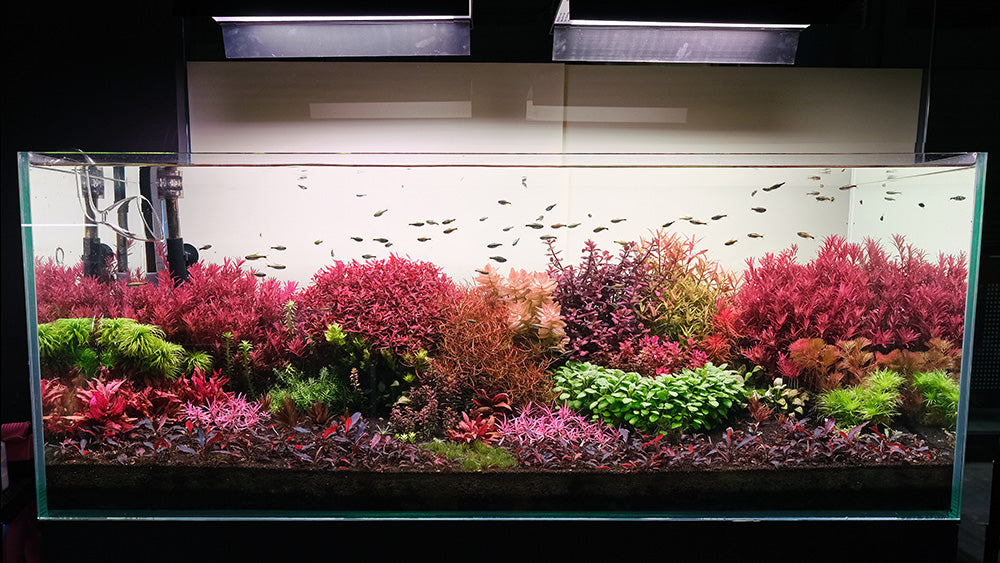Your Cart is Empty
Local Shipping within US, Canada, EU and Australia
Local Shipping within US, Canada, EU and Australia
Water Change- how much?
February 18, 2025 4 min read

Regular water changes are extremely beneficial. It keeps algae at bay by removing organic waste, most of which cannot be measured by hobbyist test kits. And fresh water rebalances the buildup of minerals and supplements that have been added over time. For a fast-growing tank with a lively fish population, we recommend weekly water changes. For a slow-growing tank with very light stocking, we can get away with water changes every 2-4 weeks.
But how much water should I change?
This is a good question and we will go through the considerations.
50%-100% Water Change
If you have perfect tap water parameters, it is fine to regularly change 100% of the water in the tank. Many breeders do this on a daily basis because they feed the fry heavily to accelerate growth. Complete water changes are necessary in such setups just to maintain water quality.
In general, 100% water change is OK if your tap water:
- Is very close to tank water in terms of water hardness & temperature
- Does not contain ammonia or heavy metals
- Is not saturated with carbon dioxide
Most of the bacteria in a mature tank are found in the substrate and filter, so losing a small amount through a large water change is insignificant.
Large water changes have many advantages. Large water changes are great at removing both dissolved organic waste and particulate waste. It also removes algae spores and allows us to rebalance water parameters that may have shifted during the week. The benefit of removing organic debris far outweighs the small fluctuations caused by the large water change.
Sensitive animals, such as spawning fish or shrimp, can be stressed by the disturbance of frequent large water changes. This is definitely a factor to be concerned about, but it is more related to the emptying of the tank than the water change itself.
But remember, unless you are certain that your tap water has zero or very little chlorine and chloramines, always use a dechlorinator/water conditioner.

This aquarium at the 2hr Aquarist gallery has a 50-70% water change done every week without fail. Tank is powered by APT Complete and APT Jazz.
30%
The tank at the top of the page shows a common scenario where hobbyists use Seiryu stone for its attractive texture. However, Seiryu is a form of limestone and increases KH (carbonate hardness). The tank shown above is a classic 2 hr hard water tank (4-7 dKH) due to the amount of Seiryu (and CO2) used. In this case, with neutral tap water (0 dKH), it is better to limit the water change to ~30% to avoid a large flux in water hardness every time we change water.
Let's use another scenario, a new tank with Aquasoil in a place with slightly hard water, say 4dKH. Aquasoils will automatically soften the water. If your tap water is 4 dKH, an Aquasoil tank can reduce it to 1 dKH or less in a few days, especially if the Aquasoil substrate is new.
With a 4 dKH difference between tap water and tank water, a 100% water change will raise the KH a few degrees. Depending on how sensitive your animals and plants are, this may be a problem. In such cases, it is better to limit your water changes to about 30%.
Finally, some animals, such as the coral red pencilfish below, are more sensitive to water parameters and disturbances. If you have more sensitive animals, it makes sense to limit water changes to 40% or less. In general, 30% is a sweet spot that works well for most tanks.

10%-20%
For some folks with more problematic tap water, large water changes can sometimes present issues. For example, some tap water sources contains heavy metals. In matured tanks, plants and substrate absorb heavy metals from the water column. A large water change in such scenarios may spike heavy metal concentration high enough to affect sensitive livestock such as shrimps.
Some tap water may also contain ammonia - this coupled with a high pH can induce ammonia toxicity. In matured tanks, plants absorb ammonia and stabilise the environment. If your tap water is really poor, then doing smaller water changes may actually give better outcomes. In such cases, try a 10% to 20% water change, but continue to use this opportunity to vacuum detritus off the substrate, what we call Changing Water The 2Hr Way.
This more conservative approach is also appropriate for folks keeping very delicate livestock, such as more delicate Cardina shrimp species.

In summary
If you don't have detailed information on your tap water, be aware that water parameters impact plant and livestock health significantly- it is worth the investment to find out more. 30% is a good general level.
If you know your tap water, and it matches your tank and plant selection, use the luxury of regularly changing 50% or more.
If you have reason to suspect that your tap water is not ideal, or not consistent, you can limit your water change to 10%-20%, but it will be a good ideal to not over-stock your tank with livestock.
Head here to read on how we do our water changes at the 2hr Aquarist gallery
Head here to read on how to maintain aquarium substrates long term
unlock your true potential
Grow anything, defeat algae, create amazing aquascapes

























